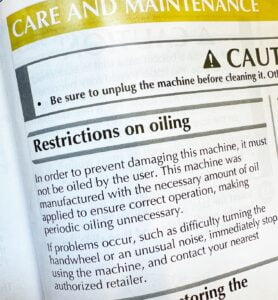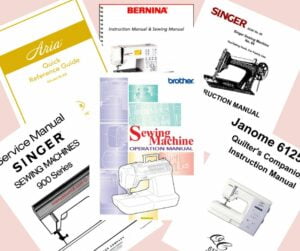10 Tips: Caring for Your Sewing Machine
Sewing machines are wonderful tools that open up a world of creativity and functionality. Whether you’re a seasoned quilter or a novice, proper care and maintenance of your sewing machine are essential to ensure it runs smoothly and lasts for years. Here are 10 tips: caring for your sewing machine, to keep your machine in top condition and a free printable chart for you.

1. Regular Cleaning
Clean the Bobbin Area: Lint and thread scraps can accumulate in the bobbin area, causing your machine to run less smoothly. After each project, take a moment to clean this area. Use a small brush or a vacuum attachment designed for sewing machines to remove debris. Be sure to turn the machine off before cleaning it.
Wipe Down the Machine: Dust and fabric fibers can settle on your machine. Use a soft, lint-free cloth to wipe down the exterior regularly. Avoid using harsh chemicals, as they can damage the machine’s surface.
2. Oil Your Machine

Some sewing machines require regular oiling to keep the moving parts functioning correctly. BUT some manuals specify that you DO NOT oil your machine, it’s only to be done at regular servicing by professional technicians. Always check your manual to find out if your machine requires oiling, and which parts need oil and how often. If your machine does require oiling, use only sewing machine oil, as other oils can damage your machine.
How to Oil (Only if Required)
- Turn off and unplug your machine.
- Clean the areas that need oiling.
- Apply a few drops of oil to the designated spots.
- Run the machine for a few minutes to distribute the oil evenly.
3. Change Needles Regularly
A dull or bent needle can cause skipped stitches, broken threads, and damage to your fabric. Change your needle after every 8-10 hours of sewing or at the beginning of a new project. This simple step can make a significant difference in the quality of your sewing.
4. Use the Right Accessories
Using the correct presser foot, needle type, and thread for your project can prevent many issues. Always refer to your sewing machine’s manual for guidance on which accessories to use for different fabrics and techniques.
5. Check Your Tension
Incorrect tension settings can lead to puckered seams, thread breakage, or uneven stitches. Regularly check and adjust the tension settings according to your fabric and thread type. If you notice any issues, refer to your manual for troubleshooting tips.
6. Proper Storage
When not in use, cover your sewing machine to protect it from dust and moisture. If you live in a humid area, consider storing it with a silica gel pack to absorb excess moisture. Avoid storing it in areas with extreme temperatures or direct sunlight.
7. Professional Servicing
Even with regular maintenance, your sewing machine will benefit from a professional service every 12-18 months. A technician can clean, oil, and adjust parts that you might not be able to reach. They can also spot potential issues before they become significant problems.
8. Use Quality Supplies
Cheap thread, low-quality fabric, and inferior needles can cause more harm than good. Invest in high-quality supplies to ensure smooth operation and reduce the risk of damage to your machine.

9. Refer to the Manual
Your sewing machine’s manual is a valuable resource. It contains specific maintenance instructions, troubleshooting tips, and information on your machine’s unique features. Keep it handy and refer to it regularly.
10. Be Gentle
Treat your sewing machine with care. Avoid forcing fabric through it, and be gentle when threading needles and inserting bobbins. Treating your machine gently will help prevent mechanical issues and prolong its life.
10 Tips: Caring for Your Sewing Machine Chart
| Tip | Description |
|---|---|
| Regular Cleaning | Clean the bobbin area after each project, be sure to turn the machine off first. Wipe down the exterior regularly with a soft cloth to remove dust and lint. |
| Oil Your Machine | Regularly oil the designated parts of your machine using sewing machine oil. Follow the manufacturer’s instructions for frequency and application points. |
| Change Needles Regularly | Replace the needle after every 8-10 hours of sewing or at the start of a new project to ensure sharpness and prevent damage. |
| Use the Right Accessories | Use the correct presser foot, needle type, and thread for your project. Refer to your manual for guidance on the appropriate accessories. |
| Check Your Tension | Regularly adjust the tension settings according to your fabric and thread type to ensure even stitches and prevent puckering or thread breakage. |
| Proper Storage | Cover your sewing machine when not in use to protect it from dust and moisture. Store in a cool, dry place away from direct sunlight and extreme temperatures. |
| Professional Servicing | Have your machine professionally serviced every 12-18 months to clean, oil, and adjust hard-to-reach parts and address potential issues early. |
| Use Quality Supplies | Invest in high-quality thread, fabric, and needles to ensure smooth operation and prevent damage to your machine. |
| Refer to the Manual | Keep your sewing machine’s manual handy for specific maintenance instructions, troubleshooting tips, and information on unique features. |
| Be Gentle | Handle your machine with care. Avoid forcing fabric through the machine and be gentle when threading needles and inserting bobbins to prevent mechanical issues. |
Taking the time to care for your sewing machine properly will pay off in the long run. Regular maintenance not only extends the life of your machine but also ensures that your sewing projects are smooth and enjoyable. By following these tips, you’ll keep your sewing machine running like new, allowing you to focus on creating beautiful and functional items for years to come.
Happy Sewing! ❤️




